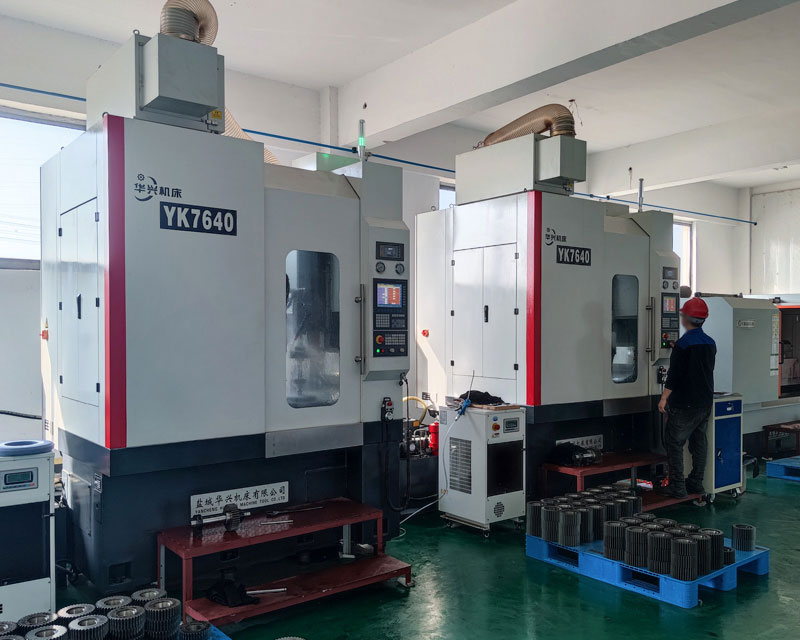
Swing bearings, such as the CAT 326 353-0649, are crucial components in heavy machinery, enabling smooth rotational movement and bearing significant loads. These bearings are integral to the efficient operation of excavators, cranes, and other equipment. However, like any mechanical part, swing bearings are susceptible to contamination. Contaminants can significantly impact the performance, lifespan, and safety of the machinery. Identifying the specific signs of contamination early can prevent extensive damage, costly repairs, and downtime. This blog will explore the specific signs of contamination in a CAT 326 353-0649 swing bearing, providing a detailed guide on how to recognize and address these issues to ensure optimal performance and longevity.

A swing bearing, also known as a slewing bearing or turntable bearing, is a rotational rolling-element bearing that typically supports heavy axial, radial, and moment loads. It consists of an inner and outer ring with raceways and rolling elements such as balls or rollers, which facilitate smooth rotation. The CAT 326 353-0649 swing bearing is a specific model used in CAT excavators, renowned for its durability and precision.
Swing bearings are designed to handle various loads and are essential for the pivotal rotation of the upper structure of excavators. They ensure that the machine can swing left or right while maintaining stability and balance. Given their critical role, maintaining the cleanliness and integrity of swing bearings is paramount.
Contamination in swing bearings can occur due to various reasons, including inadequate sealing, improper lubrication, and environmental factors. Identifying contamination early is crucial to prevent extensive damage and ensure the longevity of the bearing. Here are some specific signs of contamination in a CAT 326 353-0649 swing bearing:
One of the most apparent signs of contamination in a swing bearing is unusual noise. This can manifest as grinding, clicking, or squeaking sounds during operation. Contaminants such as dirt, dust, or metal particles can interfere with the smooth movement of the rolling elements, causing friction and noise.
Increased vibration during the operation of machinery is another clear sign of bearing contamination. Contaminants disrupt the smooth rolling action of the bearing, causing uneven rotation and vibration.
A contaminated swing bearing can experience a rise in operating temperature. Contaminants cause increased friction and wear, leading to excessive heat generation.
The condition of the lubricant within the swing bearing can provide significant insights into contamination levels. Contaminated lubricant can lose its effectiveness, leading to increased wear and damage.
Physical inspection of the bearing components can reveal signs of contamination. Wear and tear on the raceways, rolling elements, and seals can indicate the presence of contaminants.
Contamination can lead to various operational issues, such as reduced efficiency, unexpected stoppages, and increased maintenance requirements.
Understanding the causes of contamination can help in implementing preventive measures to protect the swing bearings. Some common causes include:
Implementing preventive measures can help protect the swing bearing from contamination and ensure optimal performance. Some key preventive measures include:
Contamination in a CAT 326 353-0649 swing bearing can significantly impact its performance, lifespan, and safety. Identifying the specific signs of contamination early can prevent extensive damage, costly repairs, and downtime. Unusual noise, increased vibration, temperature rise, lubricant degradation, wear and tear on bearing components, and operational issues are key indicators of contamination. Understanding the causes of contamination and implementing preventive measures, such as regular maintenance, proper sealing, quality lubrication, clean environment, and proper handling and installation, can help protect the swing bearing and ensure optimal performance.
Q1: What are the common signs of contamination in a CAT 326 353-0649 swing bearing?
A1 : Common signs of contamination include unusual noise (grinding, clicking, or squeaking), increased vibration (high-frequency and low-frequency), temperature rise (localized and overall), lubricant degradation (discoloration and consistency changes), wear and tear on bearing components (scratches and scoring, seal damage), and operational issues (reduced efficiency, unexpected stoppages, increased maintenance requirements).
Q2: What causes contamination in swing bearings?
A2 : Contamination in swing bearings can be caused by poor sealing, inadequate lubrication, environmental factors (harsh or dirty environments), and improper handling and installation.
Q3: How can I prevent contamination in my swing bearing?
A3 : Preventive measures include regular maintenance and inspections, ensuring proper sealing, using high-quality lubricants, maintaining a clean working environment, and following proper handling and installation procedures.
Q4: Why is it important to remove contamination from swing bearings?
A4 : Removing contamination from swing bearings is crucial to prevent extensive damage, costly repairs, and downtime. Contamination can lead to increased wear, reduced performance, and potential bearing failure, affecting the overall efficiency and safety of the machinery.
Q5: How often should I inspect my swing bearing for contamination?
A5 : Regular inspections should be conducted based on the operating conditions and usage of the machinery. Frequent inspections are recommended for harsh or dirty environments to identify and address potential contamination issues early. Regular maintenance schedules should also be followed to ensure the optimal performance and longevity of the swing bearing.